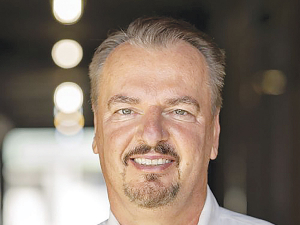The politics of climate change
OPINION: The Financial Times, a major international newspaper, featured New Zealand on its front page at the beginning of June. It wasn't for the right reasons.
 Frank Mitloehner says the GWP (100) measure has major limitations when livestock numbers are constant and/or falling and methane is being reduced.
Frank Mitloehner says the GWP (100) measure has major limitations when livestock numbers are constant and/or falling and methane is being reduced.
Recognition is urgently needed on a new measure for short and long-lived greenhouse gases and their impact on global warming.
That was the strong message given to attendees at the recent Red Meat Sector Conference by Dr Frank Mitloehner of the University of California Davis - a world expert on livestock emissions research.
He explained how the measure of GWP (100) - the matrix used to calculate the impact of different gas emissions on warming for the past 30 years - is "problematic" when methane levels are falling.
"It has real strong limitations when livestock numbers are constant and/or falling and methane is being reduced."
Mitloehner told attendees that methane is a potent greenhouse gas (GHG), with its global warming potential (GWP) 28 stronger than that of carbon.
"Methane is a fast and furious gas, meaning it is 28 times more powerful than carbon, but it also disappears quickly."
He explained how emissions produced from fossil fuels are vastly different to those produced by livestock because the half-life of methane is around 12 years, compared to the half-life of carbon, which is more like 1,000 years.
"There is a molecule in the atmosphere called hydraulic radical that destroys methane, which generally takes about a decade. However, the same does happen with CO2 (carbon) or nitrous oxide."
Mitloehner says this means when you drive a car, the emissions it puts into the atmosphere keeps a warming effect for 1,000 years. However, he explained that with a constant source of methane (same number of livestock) then there is no additional warming.
“So, if you reduce methane emission then you reduce warming.”
He said this is what the Paris Accord called for – a reduction in global warming.
“Warming is what it is all about and that is why we care about greenhouse gas emissions.”
Mitloehner said if livestock numbers stay constant then they do not add to warming, but if these numbers fall that actually reduces warming. He gave as an example the drop in the US dairy herd from a peak herd of 25 million 50 years ago to around 9 million today.
“However, with these 9 million dairy cows we are now producing 16% more milk than we use to with 25 million. That means the carbon footprint of a gallon of milk today is two-thirds of what it was in 1950.”
Mitloehner says research at Oxford University found that GWP (100) overestimates the impact of constant sources of methane on warming by a factor of 4.
“GWP (100) is used all over the world to estimate methane sources on warming, but it doesn’t do a proper job for constant sources of methane or reducing trajectories either.”
He says the development of Oxford’s new matrix GWP* properly calculates the impact of methane on climate over time.
“Methane is not a stop gas, it is a flow gas. It is not just produced but it is also atmospherically removed,” Mitloehner explained.
“If you keep a herd size constant, you don’t add additional carbon to the atmosphere and no additional warming to our planet.”
He added, if livestock numbers drop, then you are reducing methane and having the same impact as planting forests in removing carbon from the atmosphere and leading to negative warming.
“Methane is not just C02 on steroids and is not a super pollutant,” Mitloehner concluded. “Methane is a super opportunity for the agricultural sector. If we can manage methane, agriculture can be part of the solution to reduce global warming.”
Mitloehner says methane reductions should be encouraged so farmers can be part of the climate solution. However, he believes policies to encourage reductions should take a carrot and not a stick approach.
New Zealand needs a new healthcare model to address rising rates of obesity in rural communities, with the current system leaving many patients unable to access effective treatment or long-term support, warn GPs.
Southland farmers are being urged to put safety first, following a spike in tip offs about risky handling of wind-damaged trees
Third-generation Ashburton dairy farmers TJ and Mark Stewart are no strangers to adapting and evolving.
When American retail giant Cosco came to audit Open Country Dairy’s new butter plant at the Waharoa site and give the green light to supply their American stores, they allowed themselves a week for the exercise.
Fonterra chair Peter McBride says the divestment of Mainland Group is their last significant asset sale and signals the end of structural changes.
Thirty years ago, as a young sharemilker, former Waikato farmer Snow Chubb realised he was bucking a trend when he started planting trees to provide shade for his cows, but he knew the animals would appreciate what he was doing.

OPINION: Your old mate welcomes the proposed changes to local government but notes it drew responses that ranged from the reasonable…
OPINION: A press release from the oxygen thieves running the hot air symposium on climate change, known as COP30, grabbed your…